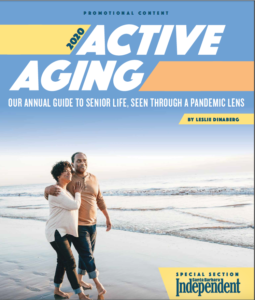 After the July 2020 acquisition of Goleta-based InTouch Health—for approximately $150 million in cash and 4.6 million shares of stock—Teladoc Health is well positioned in the global telehealth market and also a large employer here, with about 230 positions in Santa Barbara County. Joe DeVivo, Teladoc’s president of hospitals and health systems, discussed the technology, ever more important during COVID.
After the July 2020 acquisition of Goleta-based InTouch Health—for approximately $150 million in cash and 4.6 million shares of stock—Teladoc Health is well positioned in the global telehealth market and also a large employer here, with about 230 positions in Santa Barbara County. Joe DeVivo, Teladoc’s president of hospitals and health systems, discussed the technology, ever more important during COVID.
WHAT DOES TELADOC DO? The mission of Teladoc Health is to transform how people access and experience health-care around the world. With virtual care, we are enabling patients to access care on their terms—from general medical issues like cold and flu to chronic conditions, including mental health, and complicated medical issues.
HOW HAS THE COMPANY GROWN? Teladoc Health was established for what has come to be known as virtual urgent care: providing access to board-certified physicians via phone, app, or website for acute health needs like cold, flu, upper respiratory issues, pinkeye, and more.
Through multiple acquisitions, the company not only expanded globally, now operating in 175 countries, but also added clinical capabilities, covering more health conditions across the spectrum of care, including dermatology, mental health, expert medical services, and more.
HOW IS THE PANDEMIC AMPLIFYING THINGS? COVID-19 has exponentially increased the number of hospitals and health systems utilizing virtual-care platforms as well as expanded the use cases for those who had already deployed a virtual-care platform. While we knew in January that the InTouch transaction would play a key role in our growth, we couldn’t have predicted the level of need it’s enabling us to meet for hospital systems now motivated to create comprehensive virtual-care strategies.
Our pipeline with hospitals and health systems remains strong for the rest of 2020 and 2021, set to grow over 35 percent in 2020. Teladoc Health is now partnering with more than 60 of the top 100 hospitals.
WHAT IS INTOUCH FOUNDER YULUN WANG’S CURRENT ROLE? In his capacity as fellow with Teladoc Health, Yulun Wang will now focus on the importance of growing virtual health-care opportunities for underserved populations around the globe with the World Telehealth Initiative. We will continue to foster the Teladoc Health relationship with UCSB, and we also see expanding opportunities for students to participate in Yulun’s work with the World Telehealth Initiative. intouchhealth.com
Tech Talk Special Issue for the Santa Barbara Independent, originally published on October 1, 2020.
To read the issue as it appeared in print, please click here, Tech Talk 768_10_01_20



